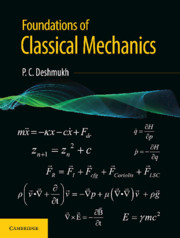Book contents
- Frontmatter
- Dedication
- Contents
- List of Figures
- List of Tables
- Foreword
- Preface
- Introduction
- 1 Laws of Mechanics and Symmetry Principles
- 2 Mathematical Preliminaries
- 3 Real Effects of Pseudo-forces: Description of Motion in Accelerated Frame of Reference
- 4 Small Oscillations and Wave Motion
- 5 Damped and Driven Oscillations; Resonances
- 6 The Variational Principle
- 7 Angular Momentum and Rigid Body Dynamics
- 8 The Gravitational Interaction in Newtonian Mechanics
- 9 Complex Behavior of Simple System
- 10 Gradient Operator, Methods of Fluid Mechanics, and Electrodynamics
- 11 Rudiments of Fluid Mechanics
- 12 Basic Principles of Electrodynamics
- 13 Introduction to the Special Theory of Relativity
- 14 A Glimpse of the General Theory of Relativity
- Index
5 - Damped and Driven Oscillations; Resonances
Published online by Cambridge University Press: 06 November 2019
- Frontmatter
- Dedication
- Contents
- List of Figures
- List of Tables
- Foreword
- Preface
- Introduction
- 1 Laws of Mechanics and Symmetry Principles
- 2 Mathematical Preliminaries
- 3 Real Effects of Pseudo-forces: Description of Motion in Accelerated Frame of Reference
- 4 Small Oscillations and Wave Motion
- 5 Damped and Driven Oscillations; Resonances
- 6 The Variational Principle
- 7 Angular Momentum and Rigid Body Dynamics
- 8 The Gravitational Interaction in Newtonian Mechanics
- 9 Complex Behavior of Simple System
- 10 Gradient Operator, Methods of Fluid Mechanics, and Electrodynamics
- 11 Rudiments of Fluid Mechanics
- 12 Basic Principles of Electrodynamics
- 13 Introduction to the Special Theory of Relativity
- 14 A Glimpse of the General Theory of Relativity
- Index
Summary
Lost time is never found again.
—Benjamin FranklinDISSIPATIVE SYSTEMS
Energy dissipative systems prompt us to think of physical phenomena in which energy is not conserved, it is lost. We attribute these losses to ‘friction’, which is the common term used to describe energy dissipation. Now, in our everyday experience, we are primarily involved with the gravitational and electromagnetic interactions, and both of these are essentially conservative. What is it, then, that makes friction non-conservative? What does non-conservation of energy, or ‘energy-loss’, really mean? Fundamental interactions in nature allow energy to be changed from one form to another, but not created or destroyed. It therefore seems that the term ‘energy loss’ is used somewhat loosely. We must be really careful when we talk about dissipative phenomena.
Losing money is often a matter of concern, as also other things we sometimes ‘lose’ from time to time, including time itself. Time wasted does not ever come back, of course; but nor does the time well-spent. The difference between the two is that the latter is accounted for by the gains made, and for the former there is simply no account. Isn't it merely a matter of book-keeping? It is not at all uncommon that we plan to do something during the day, and end up not doing it. We then sit and wonder where lost track of time. Did the day just skip over the afternoon and ring in the evening? If that did not happen, where was the time ‘lost’? You possibly remember everything that you did since morning, and you may be able to account for every hour you spent, except perhaps for what happened between 2:30 pm and 3 pm. That was the time you ransacked your house to find your mathematics text book, and did not realize that it took you half an hour to find it. The book had not really vanished, even if you suspected that it was lost. You had to look for it all over, from your Dad's room to your Sister's. As such, neither the book was lost, nor was half an hour scooped out of the day.
- Type
- Chapter
- Information
- Foundations of Classical Mechanics , pp. 156 - 182Publisher: Cambridge University PressPrint publication year: 2019



